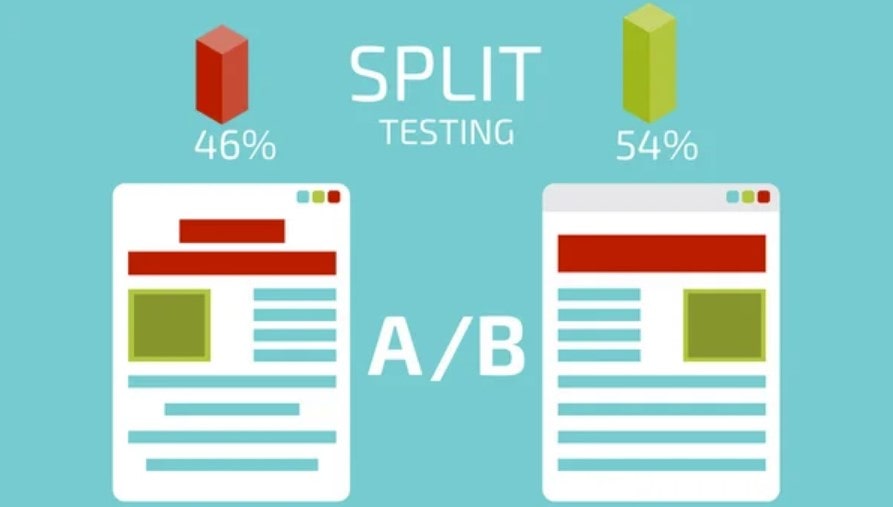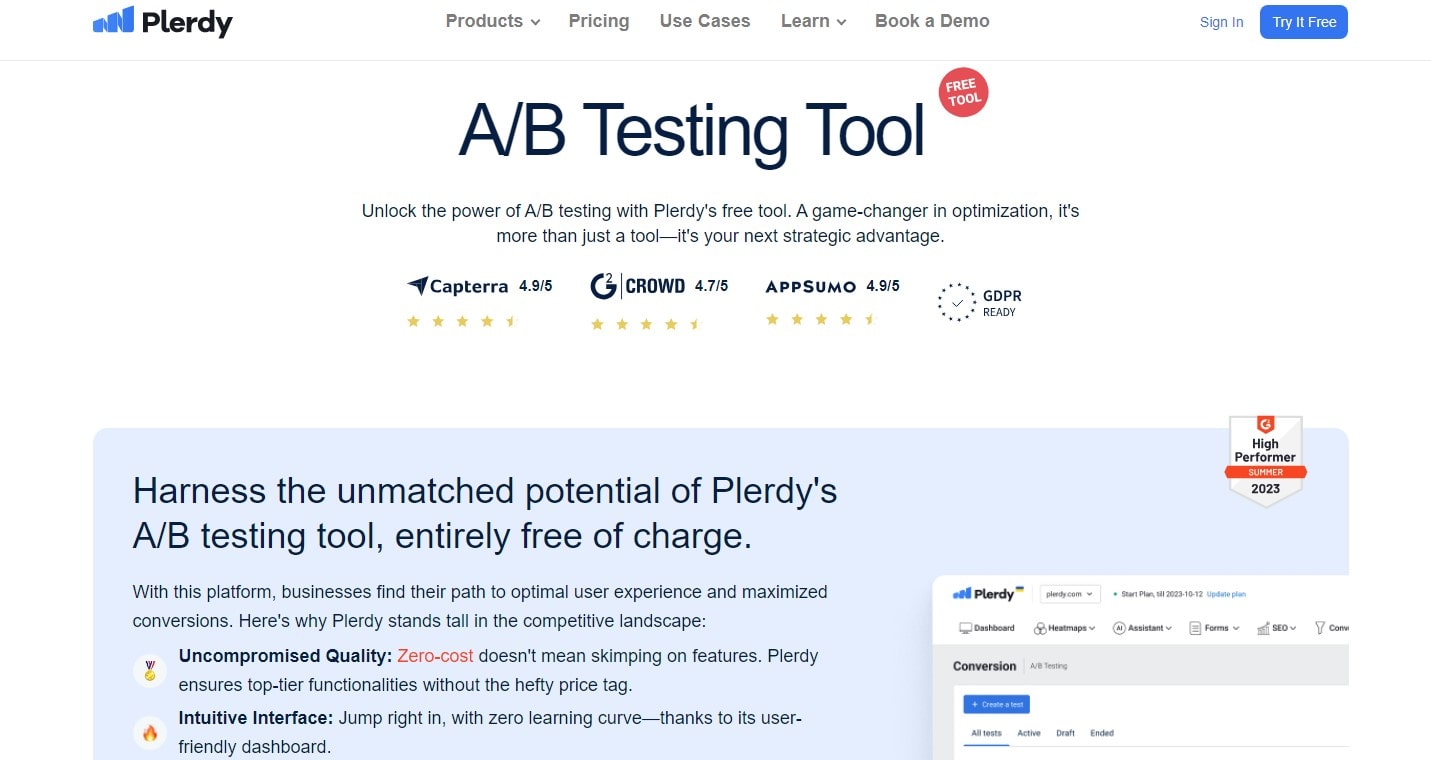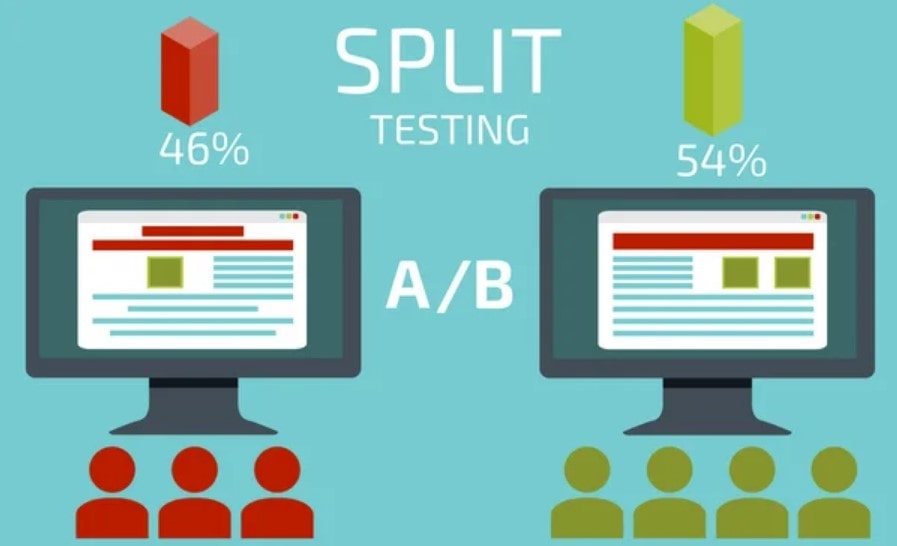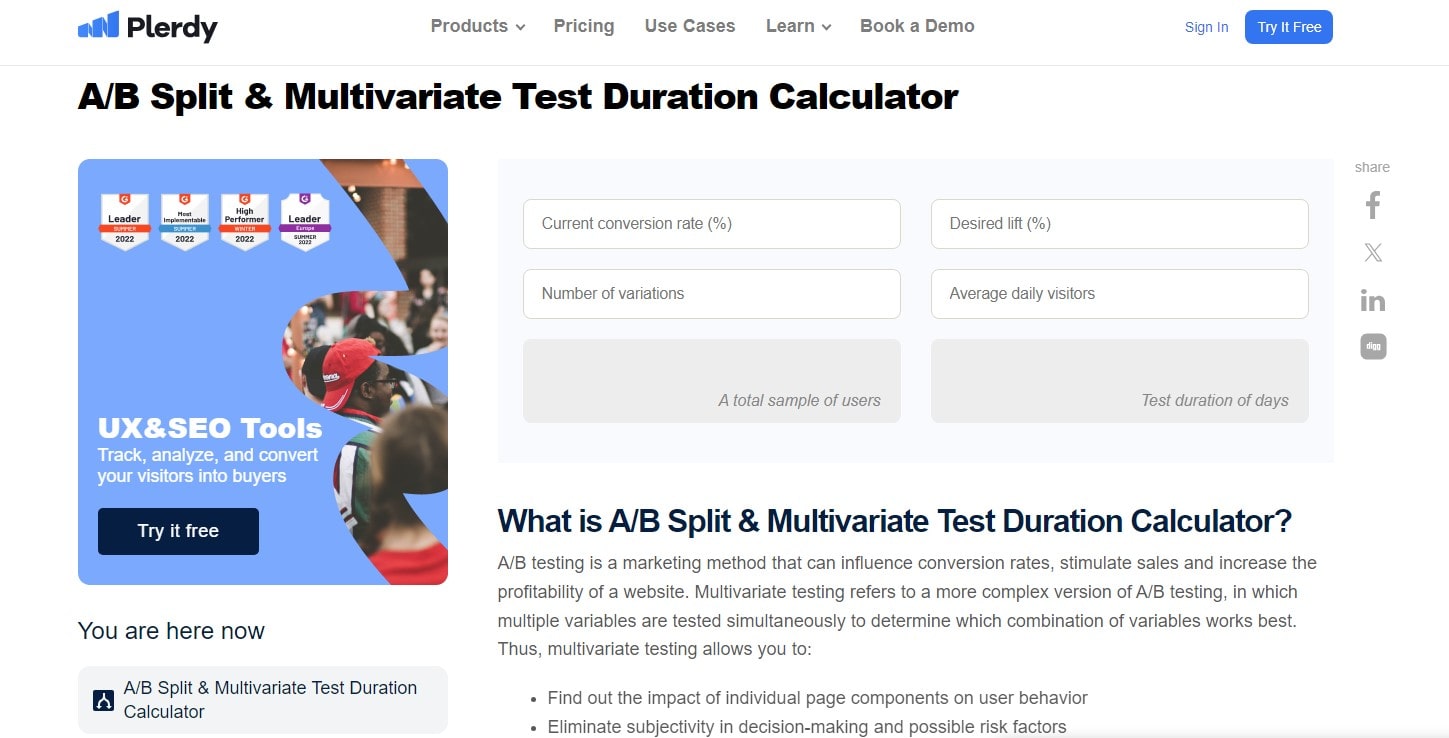Travel into the colorful realm of Shopify A/B testing; it’s about stories rather than only statistics. Every click and conversion relates a story about consumer preferences and actions. Deeply exploring the art and science of A/B testing on Shopify in “Shopify A/B Testing: The Complete Guide (2024)” will enable you to create success narratives from those stories.
We have scheduled here what you should find:
- Demystifying A/B Testing: On Shopify, break out the A/B testing procedure into simple, understandable steps to make it accessible even to beginners.
- Shopify: Particulars Create your A/B testing plans specifically for the special quirks of the Shopify platform.
- Decisions based on data: Use data to improve user experience of your Shopify store and increase conversions.
Recall that Shopify A/B testing goes beyond just modifying a button color or headline. It’s about realizing your audience and designing a Shopify experience they will find appealing. And look at Plerdy’s user behavior analysis tool for still another edge. Your go-to source for user experience (UX) improvements, conversion rate optimization (CRO), and smart A/B testing on Shopify. All set to upgrade your Shopify store? Let us start right now.
What is A/B Testing?
The foundation of any strong Shopify optimization plan is A/B testing, which also is a tried-and-true approach for improving the speed of your store. Imagine releasing two variants of a product page to find which generates more revenue. That’s A/B testing right now. Under the identical settings, two variants—A and B—go head-to-head in a split-run method hoping to identify which one beats the other.
A/B testing can help your Shopify performance soar:
- Change your checkout system to lower cart abandonment. Test it.
- Adjust product descriptions to find which language increases conversion rates the best.
- Try several layouts to find the most easily navigable design.
Owners of Shopify stores use A/B testing to make data-driven decisions leading to better customer experiences and increased conversion rates. It’s about deliberate modifications that produce observable consequences, not about guessing.
In the fashion industry, for example, testing can include trying out several picture styles — lifestyle photos against product-only images. Home goods stores might play about with pricing policies, pitting percentage discounts against dollar-amount savings to discover which appeals most to consumers.
A/B testing is an ongoing process that promotes development rather than a strategy alone. Every test clarifies consumer preferences, therefore directing Shopify founders toward more successful designs and approaches. Using A/B testing helps you not only make improvements but also change with your audience so that every modification guarantees a move towards a more successful online business.
Why A/B Testing is Crucial for Shopify Stores

A/B testing becomes a powerhouse for Shopify stores in the competitive environment of online retail, absolutely essential to keep ahead. A/B testing offers a prism into the customer’s thoughts inside this dynamic realm, enabling Shopify founders to focus on what appeals to their particular audience. Whether it’s color schemes, call-to- action buttons, or promotional banners, it’s about pushing two aspects against each other and allowing the data shape the road to increased involvement and sales.
For Shopify stores, A/B testing is not only helpful but also absolutely vital for:
- It substitutes presumptions with solid data on consumer behavior, therefore dispelling them.
- Shopify stores can identify the precise layout visitors find most navigable via split-testing.
- It focuses on resonable marketing messaging that increase click-through rates and stimulate purchases.
A/B testing reveals on Shopify a cosmetics firm whose lessons on product pages keep consumers interested and drive purchases. Alternatively think of a merchant of workout equipment who A/B tests and discovers that free shipping beats a 10% discount in attracting customers.
A/B testing serves as the compass for decision-making for Shopify stores; it guides changes in user interface, marketing plans, even product choices. Store owners open a wealth of insights by adopting a culture of A/B testing, therefore guaranteeing that every strategic action is supported by hard data. Driven by A/B testing, this persistent search of optimization not only improves shop performance but also increases the voice of the customer in the evolution of the business, thereby creating experiences that customers not only value but also return to. Shopify stores turn the dial on relevance and client satisfaction with every A/B test, therefore guiding their path to ongoing success in the e-commerce field.
A/B Testing Tool from Plerdy

To stay ahead of the fast-paced online retail market, Shopify companies absolutely must run A/B tests. Now enter Plerdy’s A/B Testing Tool, a game-changer for Shopify owners trying to improve their online stores. More than just a tool, this one offers a strategic advantage with free insights and adjustments.
Why is the tool from Plerdy above those available to Shopify users? Let us explore its main advantages now:
- Ease of Use: Start testing straight away with Plerdy’s simple layout. Designed for both new hires and seasoned experts in the Shopify space, A/B testing goes naturally.
- Real-time analytics give up-to–minute insights rather than only data. Store owners of Shopify can change their plans in response to events to keep one step ahead.
- Plerdy guarantees a consistent and simplified experience by blending naturally into your Shopify configuration.
- Data-Driven Decisions: Plerdy allows Shopify store optimization to be no more a guessing game. Every decision is guided by solid, doable data.
Consider environmentally friendly Shopify stores. Plerdy’s A/B testing allows the store to play with several layouts, call-to-action buttons, and product descriptions. Real-time analytics let one instantly evaluate which adjustments increase conversions.
For Shopify users, Plerdy distinguishes herself with these features:
- Create every test to meet the particular requirements of your Shopify store.
- Direct HTML and CSS element changes will help your Shopify site look and feel exactly as you want.
- Use interactive graphs and thorough reports to keep updated on the performance of your Shopify website.
All things considered, Shopify companies would be much benefited by Plerdy’s A/B Testing Tool. For anyone concerned about maximizing their Shopify store, its simple UI, flawless integration, and real-time data are must-have. A/B testing Plerdy and will improve your Shopify store.
Benefits of A/B Testing for Your Shopify Store

One of the most effective tools available to Shopify stores toward maximum performance is A/B testing. A/B testing slices through presumptions and replaces guessing with evidence-based tactics through well calibrated tests. This means that every element on your site—from the call-to–action buttons to the product images—pulls its weight for Shopify merchants.
A/B testing sharpens your Shopify success as follows:
- Tests several layouts and content to find what keeps users exploring and purchasing.
- Specify the precise language and design that turn browsers into consumers.
- Simplifies the Customer Journey: Find and remove the obstacles that trip up your clients on their way to check out.
- Guides Corporate Decisions: Underwrite your development plans with credible facts from A/B testing.
Imagine a Shopify boutique with an eye toward handcrafted goods. By means of A/B testing, they find that consumers choose a narrative approach to product descriptions, hence increasing engagement and purchases. Alternatively look at a Shopify high-end watch retailer. According to A/B testing, their consumers react better to scarcity strategies including building up the urgency to buy by limited-time incentives.
Shopify A/B testing is about transforming insights that propel real-world outcomes, not only about tinkering. Every test helps you to improve the performance of your store by means of a smart drill-down on what works and what wows. Using data to provide unique shopping experiences, dive into A/B testing and see how your Shopify store not only meets but sets the benchmark.
Pre-A/B Testing Considerations
It’s important to set the foundation precisely before jumping headfirst into the realm of A/B testing on Shopify. Starting with your A/B testing targets, zero things off. These should be laser-oriented; perhaps you want to cut cart abandonment rates or increase conversions? Every Shopify store has different goals, hence your testing should fit very well with these goals.
One cannot ignore additionally understanding your target audience. If you run a premium skincare Shopify business, your A/B testing might explore if high-resolution photographs influence your beauty-conscious customers more than thorough product descriptions. Conversely, the audience of a Shopify gadget store might react more favourably to technical specifications than to lifestyle images.
Not least of all, let’s not overlook the foundation of any testing plan—the Key Performance Indicators (KPIs). These numbers are your A/B testing game’s scorekeepers, telling whether you should pivot or whether you are on target.
This is a brief checklist to make sure your Shopify store is A/B test ready:
- Describe what success looks like and identify the precise measurements you are aiming at.
- Control who is buying; know the demographics, tastes, and behaviors of your target market.
- Whether your KPIs are session length, average order value, or conversion rate, know which figures you are increasing.
Those who run Shopify stores with well defined objectives, thorough audience information, and specified KPIs have the highest chance of profiting from A/B testing. It’s about smart, data-driven improvements that improve the performance of your store and appeal to your customers, not just about testing for fun.
Planning Your Shopify A/B Test
Strategically preparing your Shopify A/B test calls for thought, accuracy, and a sharp eye for detail, much as map drawing for buried treasure. First, develop a strong hypothesis that serves as your compass throughout the testing process, directing every action. It’s about informed forecasts, not about wild guesswork. Suppose you have a Shopify store focused on environmentally friendly products; your theory could be that green color themes generate more clicks than ocean blue.
Choosing appropriate A/B testing instruments comes second. These should fit very well with your Shopify configuration so you may run testing without any problems. One thinks of options like Google Optimize or Optimizely, which have strong capabilities fit for the several needs of Shopify business owners.
Remember also to specify the extent and scale of your test. This entails choosing wisely the areas of your Shopify store to test and the extent of the testing should be.
Your planning list should include these items:
- Create a testable, specifically focused hypothesis.
- Choose an A/B testing tool that fits the complexity of your store and interacts nicely with Shopify.
- Clearly define the extent of your test and decide whether you are evaluating several client touchpoints or revamping one single product page.
A well-designed Shopify A/B test reduces uncertainty and creates a road toward data-driven decisions. Whether your brand is fashion or fitness, devices, or gourmet food, A/B testing customized to the subtleties of your Shopify store is a strategic move you cannot afford to ignore.
Setting Up A/B Tests on Shopify
Creating A/B tests on Shopify requires a mix of strategic insight and technical know-how. Choosing an app or solution that syncs with Shopify starts the technical setup for A/B testing, therefore enabling precise tracking of visitor activities. Popular options with perfect connection with Shopify’s platform include Optimizely or VWO.
Making variations for your test comes next. Whether you change button colors or test several product descriptions, your differences must be clear enough to properly evaluate performance. A Shopify business offering handcrafted coffee, for example, would test two headlines: one emphasizing the taste profile and the other the bean’s source.
Crucially, ensuring test validity and compliance calls for Your Shopify A/B tests shouldn’t compromise user experience or go against any policies, either. Following privacy rules is also quite important, particularly in cases of user data harvesting for tests.
Your A/B test setup on Shopify checklist should comprise:
- Choosing an A/B testing tool that fits Shopify really nicely.
- Creating variants unique and consistent with your brand message.
- Maintaining legal standards and integrity of the user experience.
A well-run A/B test on Shopify can produce insightful results that will guide your store toward improved performance and higher consumer happiness. In digital bookshops and boutique fashion companies, Shopify A/B testing increases user involvement and conversion rates, therefore preparing every element of your store for success.
Executing the A/B Test
Running an A/B test on Shopify is where the magic happens, not only a stage in the process. Imagine yourself working on your Shopify store, changing photos, rearranging layouts, all in search of that ideal balance for your audience. A/B testing is fundamentally hands-on, dynamic means of improving your Shopify experience.
Here’s how you start A/B testing on Shopify:
- Select the test you want to administer. Maybe it’s a product description or your homepage banner. Choose one element you think might influence client behavior.
- Create the Variants: Get to work creating two variations. Assuming you’re evaluating fashion store product pages, let me state While Version B goes strong with vivid colors and interactive components, Version A might have a simple design.
- Create Your Objectives: What is the intended outcome? Higher click-through rates, more sign-ups, or more purchases clearly point to something.
- Start the test: Light your Shopify store and let the two versions run. Here is where the excitement starts—actual consumers engaging with your actual changes.
- Analyze the facts. Crushing the numbers comes time once you have sufficient data. Which version performed better? Did the strong colors of Version B increase sales in your fashion store?
A/B testing on Shopify is about knowing your customers rather than only tweaking components. This is a great tool for directly seeing what works and what doesn’t so you may make wise decisions guiding the performance of your business. Get testing, monitor the outcomes, and see as your Shopify store becomes a place your audience will find very relevant. Recall, every test moves one step toward excellence.
Analyzing A/B Test Results

It’s time to highlight the outcomes when the curtains draw on your Shopify A/B testing. Examining A/B test results is a painstaking process that sorts the figures to find practical ideas. It’s a thorough investigation of user behavior and conversion triggers unique to your Shopify audience, not a superficial check at which variant will likely fail.
You split out the analysis like this:
- Compile thorough information, transcending mere numbers to grasp the underlying reasons of the results.
- Segment data using Shopify’s strong analytics, then dive down into several customer demographics and behaviors.
- Against your defined KPIs, compare the performance of A and B noting not just the winner but also the margin and statistical relevance of the success.
It may imply looking at which product bundle offer, for a gourmet Shopify food store, produced better average order values. Regarding technology devices, maybe it’s about choosing which payment method eliminated obstacles to purchase.
The process of a comprehensive analysis consists in:compiling the test results and guaranteeing their integrity.Pulling back the layers to identify trends and patterns in the Shopify user interfaceclarifying the numbers using a direct connection to your hypothesis and testing objectives.
This analysis step in the A/B testing symphony is the encore from which you decode the performance. Every bit of information from your Shopify store builds a composite image that guides your next action, sharpens your strategy, and calibrates your online profile. What happens? a Shopify store expecting their next action and catering to consumers where they are.
Learning from A/B Testing
Using A/B testing on Shopify is like sailing under the stars; it calls for knowledge of both the light and the shadow. Analyzing results from your A/B tests offers the compass points for next projects. It’s not only a win if a simple design beats a colorful one in your Shopify clothing business. It is a lighthouse exposing your clients’ taste in design.
Here is how you might use the insights:
- Break out the “why” behind the success: visual appeal, loading speed, or clarity?
- See “failures” not as losses but as potent lessons directing your next Shopify improvement.
- Recall that every test is a stepping stone toward a better knowledge; none of them is a dead end.
Using knowledge to improve your Shopify store is mostly about strategic application:
- Use A/B testing findings on connected products or pages.
- Based on Shopify user behavior, guide marketing and product development.
- Always match these developments with your main commercial objectives and client experience.
And regarding future test preparations:
- Expanding on your knowledge, create the next Shopify A/B test with improved hypotheses.
- Breakfast of champions is a mainstay in the growth diet of your Shopify store; keep testing.
Every A/B test on Shopify allows you to remove layers of consumer psychology, improve your user experience, and create a store your customers would find home. A vibrant Shopify store’s heartbeat is this unrelenting cycle of testing, learning, and application.
Optimizing Your Store Post A/B Testing
E-commerce success depends on your Shopify store being optimized following A/B testing. Implementing the winning version you found in your A/B test comes next. This is not just turning on a switch; it’s deliberately incorporating what fit your Shopify ecosystem.
- Seamlessly include the effective components from your A/B testing into related goods or pages.
- Remember the user experience first to make sure the new additions fit right away.
From your Shopify A/B tests, scaling up winning techniques means essentially magnifying what works. Don’t stop there if a particular call-to- action button raised A/B test conversions.
- Extend these A/B testing winning pieces throughout your Shopify store.
- Extensive campaigns or even new product lines should incorporate the fundamental ideas of success.
Constant Shopify expansion depends on seeing A/B testing as a continuous tool. This is a cyclical process driven forward by your store, not a one-off occurrence.
- Create a rhythm for consistent A/B testing inside your Shopify systems.
- Rooted in ongoing A/B testing, encourage a culture of data-driven decision-making.
By means of careful A/B testing, Shopify merchants can create an environment that speaks to their target market, therefore fostering not only traffic but also loyalty and advocacy. Every change—from adjusting a headline to redesigning a navigation menu—is a deliberate move toward a shop that not only satisfies but surpasses consumer needs. Accept A/B testing as pillar of your Shopify approach and see how every iteration gets you closer to the best user experience.
A/B Testing Pitfalls to Avoid
A/B testing on Shopify calls for smart navigation; one false turn could cause your testing to veers off course. Changing too many things at once is a common mistake that could muddy the waters and makes it difficult to identify what is causing any changes in user behavior. To maintain clear, useful Shopify A/B test results:
- Change one factor at a time to separate its influence.
- Test for enough time to compile significant results.
Maintaining the integrity and dependability of your Shopify A/B tests is like laying the groundwork for a structure; it must be absolutely rock solid. Making basing decisions based on little evidence or cutting a test short can result in dubious findings.
- Follow the script; let the Shopify A/B test run its whole length.
- Before you label it statistically significant findings should be sought.
One cannot avoid detrimental effects on user experience during A/B testing on Shopify. Tests should be invisible to consumers, gently collecting information without interfering with their purchasing trip.
- Guarantee a flawless experience; customers should not feel as though they are part of an experiment.
- Throughout your Shopify A/B tests, keep load times quick and the trip seamless.
Shopify stores flourishing with A/B testing use these techniques precisely to guarantee that every test not only provides insightful information but also guarantees a perfect user experience. Keep these points under control; your Shopify A/B testing will be a flawless, value-packed performance that will help your store to be exactly what your audience wants.
Advanced Techniques in Shopify A/B Testing
Using advanced techniques will help Shopify A/B testing reach new heights. Built on the basis of A/B testing, multivariate testing magnifies it and lets several factors be simultaneously examined. This method can find strong combinations missed by a basic A/B test. Imagine a Shopify home décor firm discovering the ideal product images, descriptions, and layout using multivariate testing to build their sites design dreams.
Including behavioral targeting and personalizing a basic Shopify A/B test becomes a customer-centric tool. Shopify stores may identify which customized components appeal most by matching experiences depending on customer behavior. This strategy might help a fitness clothing company decide whether themes of high performance or wellbeing inspire its customers more.
Using artificial intelligence to improve testing gives Shopify A/B tests fresh relevance. Beyond human capacity, artificial intelligence algorithms can forecast results, automate test changes, and scale and accelerate data analysis. This system can run a Shopify gadget shop to dynamically test and adjust product recommendations, therefore meeting the always changing interests of the tech-savvy population.
Important lessons learned for advanced Shopify A/B testing:
- Look into complicated variable interactions using multivariate testing.
- Use behavioral targeting and personalizing to really engage your audience.
- Use artificial intelligence to accelerate your Shopify A/B testing operations.
These sophisticated A/B testing methods are essential components that drive smart, customer-oriented decisions for Shopify stores, not just nice extras. Using these techniques not only helps you to keep ahead of the curve but also defines it and produces a retail experience as creative as it is practical.
Finally
As we draw to a close “Shopify A/B Testing: The Complete Guide (2024),” it is abundantly evident that A/B testing is an essential tool for every Shopify store trying to survive in the cutthroat e-commerce sector. Using A/B testing can help Shopify founders make decisions, improve user experiences, and finally increase conversion rates.
This handbook has covered:
- The principles of A/B testing on Shopify demystify the process for both novices and experts.
- From product pages to checkout flows, A/B testing will greatly enhance many facets of your Shopify store.
- Actual cases of effective A/B testing techniques used by Shopify’s stores.
Recall that Shopify A/B testing calls both ongoing education and adaptability. Every test offers fresh ideas that will help you perfect your store for best operation. Plus, you can improve your A/B testing game using tools like Plerdy. Plerdy offers thorough SEO and UX analysis in addition to A/B testing, therefore improving your consumer knowledge and enabling data-driven decisions.
Thus, keep in mind whether you want to improve your current techniques or are just starting with A/B testing on Shopify:
- Keep learning and testing.
- For closer understanding, use instruments like Plerdy.
- Always give the client experience top attention.
Starting with one test, the success narrative of your Shopify store unfolds. Dive in, keep exploring, and see how great your store gets!
